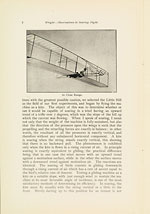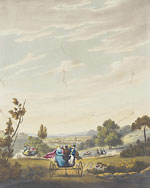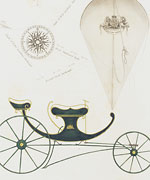The Wright Stuff
You can’t go wrong with a signed World War II-era menu, a manuscript bible in short hand, or a true first of Paradise Lost
The Wright Stuff
Wilbur Wright, Experiments and Observations in Soaring Flight, $20,000 at Sotheby’s New York on June 18.
In association terms, this 1903 offprint issue of a report delivered to the Western Society of Engineers on June 24 of that year—and first published in the August issue of their Journal—could hardly be bettered. This was Wilbur Wright’s own copy and still in the original printed gray wrappers of the special offprint issue.
It describes a wind tunnel that he and Orville had built in Dayton to test various wing and bi-plane combinations and the numerous flights they had made in the summer of 1902 with a new glider. It was these experiments that taught the brothers how a flying machine could be controlled, and six months after they had first read this paper to the WSE, they made the world’s very first powered flight at Kitty Hawk, North Carolina.
In 1999, Wilbur’s copy of the original journal issue was sold for $21,850 but surprising as it may seem, the price paid at Sotheby’s this summer has once been beaten. In 1998, a copy bearing the presentation stamp of another pioneering aeronautical engineer, Octave Chanute, was sold at $29,900 as part of the Christie’s New York sale of the great Haskell F. Norman science library.
An earlier paper that Wilbur had read to the WSE, Some Aeronautical Experiments of 1901, has made even more. At that same sale in 1998, it reached $48,300.
Go Fly a Kite
George Pocock, The Aeropleustic Art, or Navigation in the Air by use of Kites and Buoyant Sails, £2,250 ($3,245) at Christie’s South Kensington on June 7.
A schoolmaster, Pocock was fascinated by kites as a boy and in the 1820s began a series of experiments with his pupils, attaching several kites to the same string to gain enormous heights, and even managing to get kites dragging heavily laden sledges along. Taking kite-power even further, he built a four-wheeled carriage, or char-volant, that could be drawn along by two or more large kites. With a wind of twenty miles per hour, he reckoned, two kites with a combined area of one hundred square feet could pull three hundredweight, or three times that weight in a brisk gale. And what happened on a calm day? Pocock fitted his char-volant with a low-wheeled platform on which a pony was to be carried!
On January 9, 1827, reported Pocock, he had covered several miles of the road between Bristol and Marlborough at twenty miles per hour—a speed which he assured his contemporaries should not be thought dangerous—and had easily overtaken the London mail coach.
Dedicated to his former kite-flying pupils, the book provides a history of the kite and examines its potential for use on land and at sea, where he saw kites being used to tow boats or as a life-saving device from shipwrecks on a lee shore. Pocock also saw military reconnaissance and signalling potential by raising an observer to a suitable height. Balloons were later used in this way and at the century’s end by aviation pioneer, Samuel Franklin Cody, but nothing little else came of Pocock’s kite-power schemes.
The book attracted serious attention and not a little ridicule at the time, and though it is now quite rare, there has been some aeropleustics at action of late. Last October, Doyles of New York sold a slightly foxed copy in later half morocco for $2,400 and just a couple of weeks later, Sotheby’s in London sold another in stained original boards for £3,750 (then $6,230). This latest example was in the original paper-backed boards, but was spotted and occasionally dust stained, had some text leaves loose, and two of the three coloured aquatint plates detached.








 Ian McKay’s weekly column in Antiques Trade Gazette has been running for more than 30 years.
Ian McKay’s weekly column in Antiques Trade Gazette has been running for more than 30 years.


